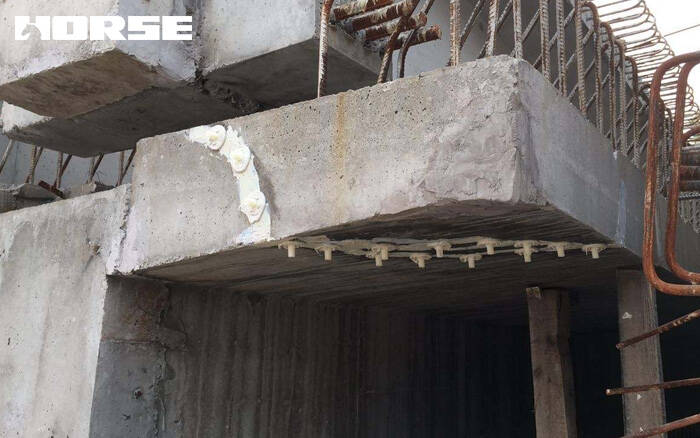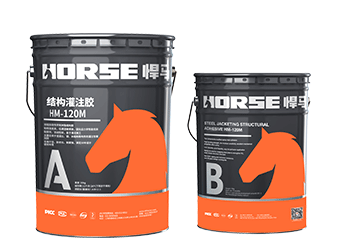Solutions
Horse Construction offers full range of structural strengthening materials with technical supports, documentation supports, products supports, project supports.
low-strength concrete reinforcement

Introduction
Structural reinforcement refers to structural reinforcement measures that are taken due to changes in the use of functions, aging structures, disasters, and engineering quality accidents that cause the structure to fail to meet the requirements for use and safety requirements.
Among various reasons, quality accidents caused by the strength of concrete failing to meet the design requirements are one of the main types of engineering quality accidents and one of the most common problems encountered in structural reinforcement projects.
Types and advantages and disadvantages of structural reinforcement methods
Reinforcement methods include large-section reinforcement method, outsourcing steel reinforcement method, prestressing reinforcement method, modified structural force transmission method reinforcement method, and external sticky steel reinforcement method. In the past 10 years, structural reinforcement technology has made great progress. Various reinforcement methods, such as the reinforcement of bonded carbon fiber cloth and the reinforcement of prestressed steel wire, have been introduced successively. These reinforcement methods have their own advantages and disadvantages.
Enlarged cross-section reinforcement method, that is, a method of increasing the cross-sectional area and reinforcement of concrete structures or structures to increase its bearing capacity and satisfy normal use. It can be widely used in the reinforcement of concrete structures such as beams, slabs, columns and other general structures. Its advantage is that it has a wide range of applications. The disadvantage is that the amount of wet work in the field is large and the maintenance period is long, which will have a certain impact on production and life. In addition, increasing the cross-sectional size of the components will also have an impact on the headroom and aesthetics of the house.
Steel jacketing reinforcement method, that is, a reinforcement method that surrounds concrete members (beams, columns) with steel sections, is divided into dry and wet methods. It is suitable for the reinforcement of the concrete structure that does not allow to increase the cross-sectional dimensions of the concrete, but also needs to increase the bearing capacity. The advantage of this method is that it is used when the column is reinforced, the construction is simple, the construction period is short, and the effect of the reinforcement is good. The shortcomings are that when the beam is reinforced, more holes need to be made in the floor slab (for welded coupling plates) and when the steel is wrapped with steel at the root of the beam, the treatment of the nodes that transfer the force to the column is more complicated. In addition, this kind of reinforcement method also has the problem that it can not ensure the transmission of shear force on the bonding surface of steel and concrete and the need for anticorrosion treatment of outsourcing steel.
Prestressed reinforcement method, that is, the method of reinforcing the structure by applying a reverse load through the prestress method. Its advantage is that it can greatly increase the load-bearing capacity of the structure. After the reinforcement, it will not affect the appearance of the structure, occupy no space, and can be constructed without stopping production. The disadvantage is that it is not suitable for the structure of concrete in the environment where the temperature is higher than 60 ℃, otherwise it should be protected.
The reinforcement method of changing the force transmission path of the structure refers to the method of strengthening the structure by changing the fulcrum to make the structural force-bearing system changed. The advantage is that after the fulcrum is added in the beam and the plate span, the bearing capacity can be greatly increased, the deflection and deformation of the beam and plate are reduced and limited, and the construction is simple, and the force is reliable. The disadvantage is that it takes up space or changes the space division, which has an impact on the use and is not applicable in many cases.
External bonding steel reinforcement method, that is, a method of bonding steel plates to the outside of concrete members to improve their bearing capacity and meet the normal use. It is suitable for general bending and tension members subjected to static force. The advantage is that it can effectively improve the stiffness and crack resistance of the reinforced structure, and can be glued to any possible as needed, without affecting the appearance of the structure and the use of space, which is convenient for construction. The shortcomings are the higher environmental requirements, the ambient temperature is not greater than 60qc, the relative humidity is not greater than 70%, and there is no chemical corrosion. Otherwise, protective measures need to be taken, and it is not suitable for the reinforcement of low-strength concrete components lower than c15.
The carbon fiber reinforcement method is a reinforcement method in which a carbon fiber cloth or a carbon fiber board is pasted on the outside of the concrete structure to improve its load-bearing capacity. This method can greatly increase the bearing capacity of components, and has the advantages of high strength, light weight, corrosion protection and simple construction. The shortcomings are due to the fact that the carbon fiber material shows linear elasticity even when it is broken, and it is obviously brittle when it is broken. It should be avoided for the reinforcement of structural members with concrete strength lower than C20.
You can find anything here you are in need of, have a trust trying on these products, you will find the big difference after that.

Modified epoxy resin structural perfusion adhesive, specifically for supporting adhesive bonded steel reinforcement

High strength, unidirectional carbon fiber fabric pre-saturated to form a carbon fiber reinforced polymer (CFRP) fabric used to strengthen structural concrete elements.

Two-components modified epoxy resin adhesive, with high quality plastic tube, double cartridge package for anchoring